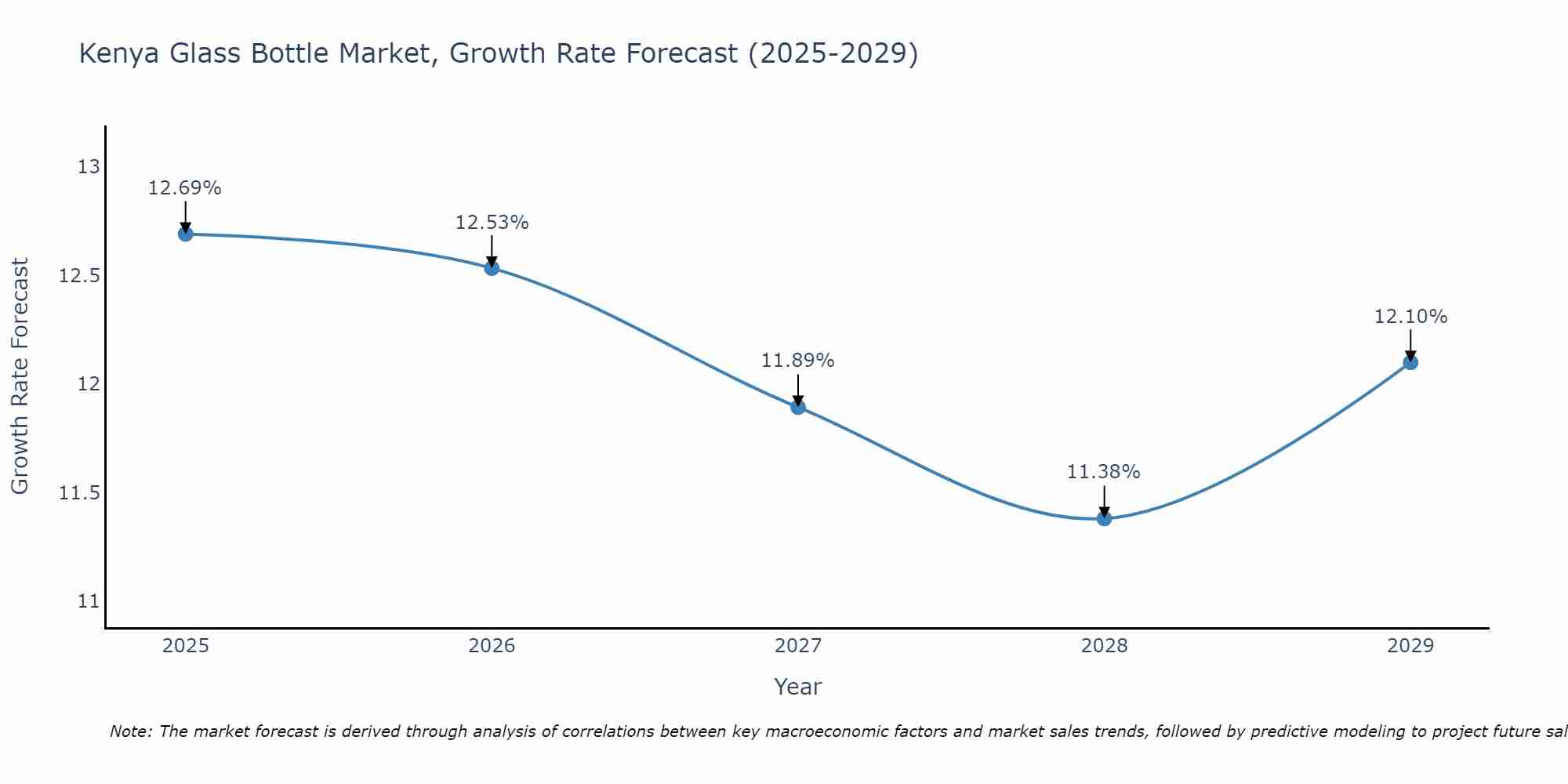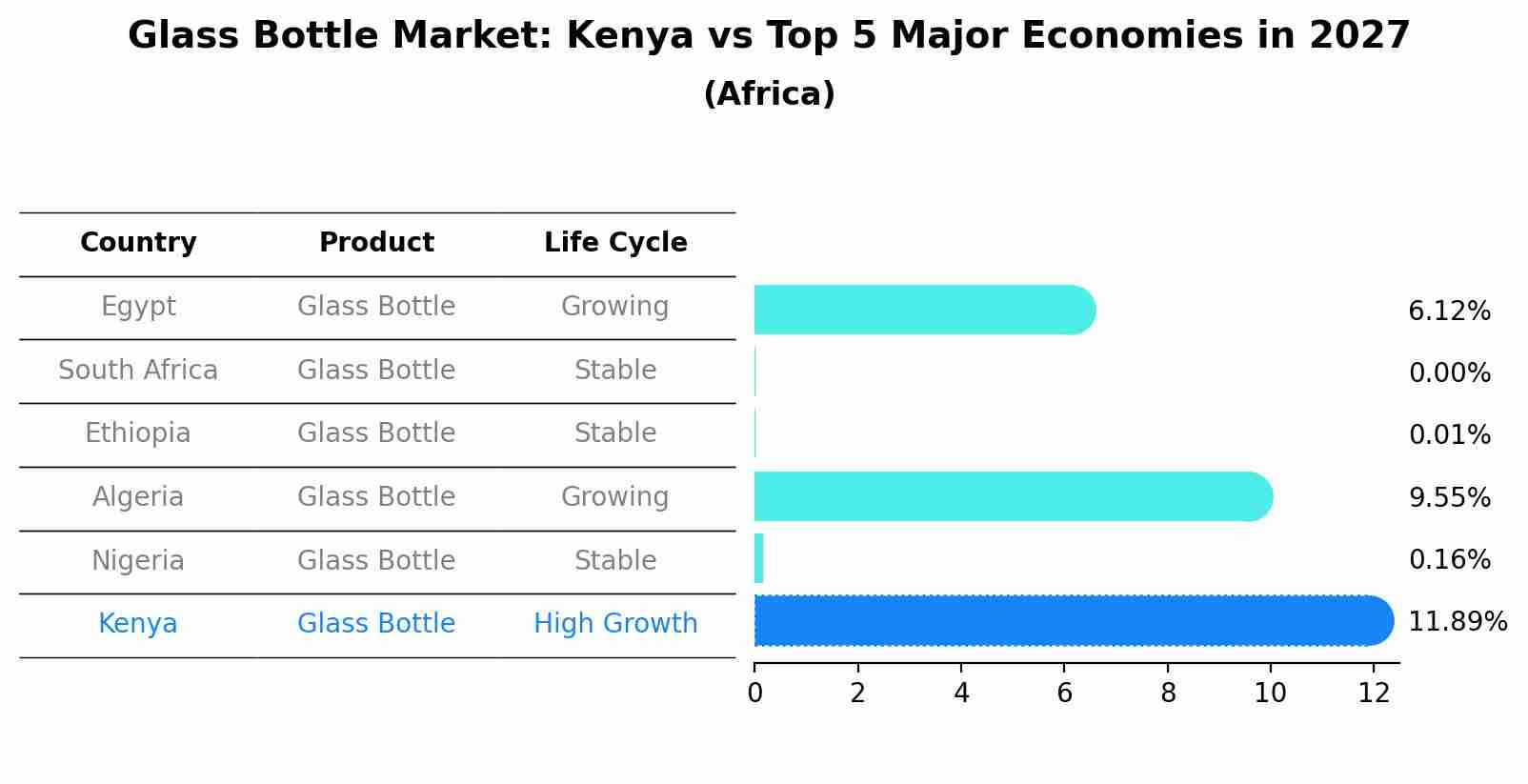Kenya Glass Bottle Market (2020-2026) | Revenue, Value, Share, Growth, Analysis, COVID-19 IMPACT, Industry, Outlook, Trends, Size, Companies & Forecast
| Product Code: ETC046170 | Publication Date: Jan 2021 | Updated Date: Apr 2025 | Product Type: Report | |
| Publisher: 6Wresearch | Author: Ravi Bhandari | No. of Pages: 70 | No. of Figures: 35 | No. of Tables: 5 |
Kenya Glass Bottle Market Size Growth Rate
The Kenya Glass Bottle Market is projected to witness mixed growth rate patterns during 2025 to 2029. Beginning strongly at 12.69% in 2025, growth softens to 12.10% in 2029.

Glass Bottle Market: Kenya vs Top 5 Major Economies in 2027 (Africa)
The Glass Bottle market in Kenya is projected to grow at a high growth rate of 11.89% by 2027, within the Africa region led by Egypt, along with other countries like South Africa, Ethiopia, Algeria and Nigeria, collectively shaping a dynamic and evolving market environment driven by innovation and increasing adoption of emerging technologies.

Kenya Glass Bottle Market Overview
The Kenya glass bottle market is experiencing growth as industries such as beverages, cosmetics, pharmaceuticals, and food packaging rely on glass containers for their premium aesthetics, product protection, and sustainability advantages. Glass bottles offer advantages such as impermeability, recyclability, and inertness, making them ideal for preserving the integrity and freshness of liquids and solids. With the increasing demand for premium packaging solutions, eco-friendly alternatives, and brand differentiation, there is a rising preference for glass bottles in Kenya. Key players in the market are offering a variety of glass bottle designs, sizes, and closures to meet the diverse packaging needs of manufacturers and brand owners in Kenya consumer goods industry.
Drivers of the market
Expansion of the beverage and alcoholic beverages industries, increasing demand for eco-friendly packaging solutions, and advancements in glass bottle manufacturing technologies drive the glass bottle market in Kenya. Glass bottles offer advantages such as recyclability, product preservation, and premium branding, driving their adoption in packaging various beverages such as water, soft drinks, beer, and spirits, and fostering market growth in the packaging industry.
Challenges of the market
Similarly, the Glass Bottle market faces hurdles related to sustainability, packaging innovations, and consumer preferences. As consumers become more environmentally conscious, challenges arise in reducing the environmental footprint of glass packaging, innovating with lightweight designs, and meeting diverse consumer demands for packaging aesthetics and functionality. Investing in recycling infrastructure, developing eco-friendly packaging solutions, and engaging consumers in sustainable practices are essential for addressing these challenges and ensuring the long-term viability of the glass bottle market.
Government Policy of the market
Government regulations in the glass bottle market focus on product quality, manufacturing standards, and environmental sustainability. Regulatory bodies may establish standards for glass composition, bottle design, and recycling processes to promote resource conservation, reduce pollution, and ensure consumer safety in the packaging industry.
Key Highlights of the Report:
- Kenya Glass Bottle Market Outlook
- Market Size of Kenya Glass Bottle Market, 2019
- Forecast of Kenya Glass Bottle Market, 2026
- Historical Data and Forecast of Kenya Glass Bottle Revenues & Volume for the Period 2016 - 2026
- Kenya Glass Bottle Market Trend Evolution
- Kenya Glass Bottle Market Drivers and Challenges
- Kenya Glass Bottle Price Trends
- Kenya Glass Bottle Porter's Five Forces
- Kenya Glass Bottle Industry Life Cycle
- Historical Data and Forecast of Kenya Glass Bottle Market Revenues & Volume By Filament Type for the Period 2016 - 2026
- Historical Data and Forecast of Kenya Glass Bottle Market Revenues & Volume By Moulded for the Period 2016 - 2026
- Historical Data and Forecast of Kenya Glass Bottle Market Revenues & Volume By Tubular for the Period 2016 - 2026
- Historical Data and Forecast of Kenya Glass Bottle Market Revenues & Volume By Application for the Period 2016 - 2026
- Historical Data and Forecast of Kenya Glass Bottle Market Revenues & Volume By Beverage for the Period 2016 - 2026
- Historical Data and Forecast of Kenya Glass Bottle Market Revenues & Volume By Food for the Period 2016 - 2026
- Historical Data and Forecast of Kenya Glass Bottle Market Revenues & Volume By Cosmetics for the Period 2016 - 2026
- Historical Data and Forecast of Kenya Glass Bottle Market Revenues & Volume By Pharmaceutical for the Period 2016 - 2026
- Historical Data and Forecast of Kenya Glass Bottle Market Revenues & Volume By Other for the Period 2016 - 2026
- Kenya Glass Bottle Import Export Trade Statistics
- Market Opportunity Assessment By Filament Type
- Market Opportunity Assessment By Application
- Kenya Glass Bottle Top Companies Market Share
- Kenya Glass Bottle Competitive Benchmarking By Technical and Operational Parameters
- Kenya Glass Bottle Company Profiles
- Kenya Glass Bottle Key Strategic Recommendations
Frequently Asked Questions About the Market Study (FAQs):
1 Executive Summary |
2 Introduction |
2.1 Key Highlights of the Report |
2.2 Report Description |
2.3 Market Scope & Segmentation |
2.4 Research Methodology |
2.5 Assumptions |
3 Kenya Glass Bottle Market Overview |
3.1 Kenya Country Macro Economic Indicators |
3.2 Kenya Glass Bottle Market Revenues & Volume, 2019 & 2026F |
3.3 Kenya Glass Bottle Market - Industry Life Cycle |
3.4 Kenya Glass Bottle Market - Porter's Five Forces |
3.5 Kenya Glass Bottle Market Revenues & Volume Share, By Filament Type, 2019 & 2026F |
3.6 Kenya Glass Bottle Market Revenues & Volume Share, By Application, 2019 & 2026F |
4 Kenya Glass Bottle Market Dynamics |
4.1 Impact Analysis |
4.2 Market Drivers |
4.3 Market Restraints |
5 Kenya Glass Bottle Market Trends |
6 Kenya Glass Bottle Market, By Types |
6.1 Kenya Glass Bottle Market, By Filament Type |
6.1.1 Overview and Analysis |
6.1.2 Kenya Glass Bottle Market Revenues & Volume, By Filament Type, 2016 - 2026F |
6.1.3 Kenya Glass Bottle Market Revenues & Volume, By Moulded, 2016 - 2026F |
6.1.4 Kenya Glass Bottle Market Revenues & Volume, By Tubular, 2016 - 2026F |
6.2 Kenya Glass Bottle Market, By Application |
6.2.1 Overview and Analysis |
6.2.2 Kenya Glass Bottle Market Revenues & Volume, By Beverage, 2016 - 2026F |
6.2.3 Kenya Glass Bottle Market Revenues & Volume, By Food, 2016 - 2026F |
6.2.4 Kenya Glass Bottle Market Revenues & Volume, By Cosmetics, 2016 - 2026F |
6.2.5 Kenya Glass Bottle Market Revenues & Volume, By Pharmaceutical, 2016 - 2026F |
6.2.6 Kenya Glass Bottle Market Revenues & Volume, By Other, 2016 - 2026F |
7 Kenya Glass Bottle Market Import-Export Trade Statistics |
7.1 Kenya Glass Bottle Market Export to Major Countries |
7.2 Kenya Glass Bottle Market Imports from Major Countries |
8 Kenya Glass Bottle Market Key Performance Indicators |
9 Kenya Glass Bottle Market - Opportunity Assessment |
9.1 Kenya Glass Bottle Market Opportunity Assessment, By Filament Type, 2019 & 2026F |
9.2 Kenya Glass Bottle Market Opportunity Assessment, By Application, 2019 & 2026F |
10 Kenya Glass Bottle Market - Competitive Landscape |
10.1 Kenya Glass Bottle Market Revenue Share, By Companies, 2019 |
10.2 Kenya Glass Bottle Market Competitive Benchmarking, By Operating and Technical Parameters |
11 Company Profiles |
12 Recommendations |
13 Disclaimer |
- Single User License$ 1,995
- Department License$ 2,400
- Site License$ 3,120
- Global License$ 3,795
Search
Thought Leadership and Analyst Meet
Our Clients
Related Reports
- Afghanistan Apparel Market (2026-2032) | Growth, Outlook, Industry, Segmentation, Forecast, Size, Companies, Trends, Value, Share, Analysis & Revenue
- Canada Oil and Gas Market (2026-2032) | Share, Segmentation, Value, Industry, Trends, Forecast, Analysis, Size & Revenue, Growth, Competitive Landscape, Outlook, Companies
- Germany Breakfast Food Market (2026-2032) | Industry, Share, Growth, Size, Companies, Value, Analysis, Revenue, Trends, Forecast & Outlook
- Australia Briquette Market (2025-2031) | Growth, Size, Revenue, Forecast, Analysis, Trends, Value, Share, Industry & Companies
- Vietnam System Integrator Market (2025-2031) | Size, Companies, Analysis, Industry, Value, Forecast, Growth, Trends, Revenue & Share
- ASEAN and Thailand Brain Health Supplements Market (2025-2031) | Strategy, Consumer Insights, Analysis, Investment Trends, Opportunities, Growth, Size, Share, Industry, Revenue, Segments, Value, Segmentation, Supply, Forecast, Restraints, Outlook, Competition, Drivers, Trends, Demand, Pricing Analysis, Competitive, Strategic Insights, Companies, Challenges
- ASEAN Bearings Market (2025-2031) | Strategy, Consumer Insights, Analysis, Investment Trends, Opportunities, Growth, Size, Share, Industry, Revenue, Segments, Value, Segmentation, Supply, Forecast, Restraints, Outlook, Competition, Drivers, Trends, Demand, Pricing Analysis, Competitive, Strategic Insights, Companies, Challenges
- Europe Flooring Market (2025-2031) | Outlook, Share, Industry, Trends, Forecast, Companies, Revenue, Size, Analysis, Growth & Value
- Saudi Arabia Manlift Market (2025-2031) | Outlook, Size, Growth, Trends, Companies, Industry, Revenue, Value, Share, Forecast & Analysis
- Uganda Excavator, Crane, and Wheel Loaders Market (2025-2031) | Strategy, Consumer Insights, Analysis, Investment Trends, Opportunities, Growth, Size, Share, Industry, Revenue, Segments, Value, Segmentation, Supply, Forecast, Restraints, Outlook, Competition, Drivers, Trends, Demand, Pricing Analysis, Competitive, Strategic Insights, Companies, Challenges
Industry Events and Analyst Meet
Whitepaper
- Middle East & Africa Commercial Security Market Click here to view more.
- Middle East & Africa Fire Safety Systems & Equipment Market Click here to view more.
- GCC Drone Market Click here to view more.
- Middle East Lighting Fixture Market Click here to view more.
- GCC Physical & Perimeter Security Market Click here to view more.
6WResearch In News
- Doha a strategic location for EV manufacturing hub: IPA Qatar
- Demand for luxury TVs surging in the GCC, says Samsung
- Empowering Growth: The Thriving Journey of Bangladesh’s Cable Industry
- Demand for luxury TVs surging in the GCC, says Samsung
- Video call with a traditional healer? Once unthinkable, it’s now common in South Africa
- Intelligent Buildings To Smooth GCC’s Path To Net Zero


















